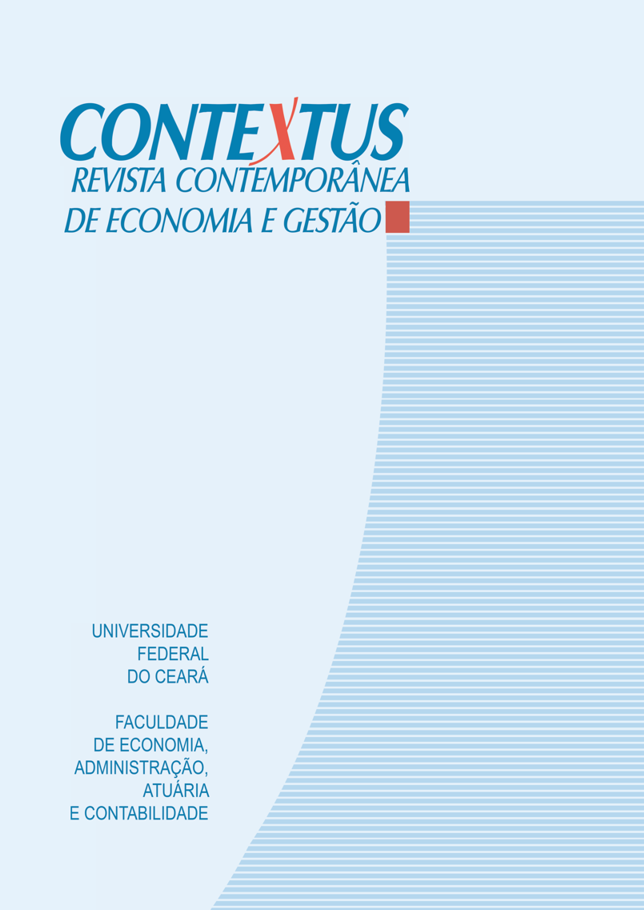Orquestación de redes de innovación en políticas públicas: El Programa de Clústeres de Innovación Económica del Gobierno del Estado de Ceará
DOI:
https://doi.org/10.19094/contextus.2023.81742Palabras clave:
orquestación de redes de innovación, políticas públicas de innovación, apropiabilidad de la innovación, estabilidad de la red, formación de clústeres de innovaciónResumen
Esta investigación tiene como objetivo presentar el contexto del Programa de Clústeres de Innovación Económica (PCEI) como un proyecto orquestador de redes públicas de innovación, analizando cómo el Programa utilizó constructos de orquestación en su relación, constituidos por diferentes actores (Universidades, Gobierno, Investigadores, empresarios y políticos) que dieron forma a las políticas públicas. Para la recolección de datos, se realizaron entrevistas semiestructuradas a treinta actores de los ecosistemas locales de innovación. Entre los resultados obtenidos, se concluye que el PCEI fomentó y gestionó de manera sistemática y significativa las interacciones entre sus actores, generando un gran impacto positivo en los resultados de innovación de la red.
Citas
Adam, J. (2008). A linguística textual: Introdução à análise textual dos discursos. São Paulo: Cortez.
Ahrweiler, P., & Keane, M. T. (2013). Innovation Networks, Mind & Society, 12, 73-90.
Ahuja, G. (2000). Collaboration networks, structural holes and innovation: A longitudinal study. Administrative Science Quarterly. 45, 425-455.
Alberti, A., & Bertucci, G. (2006). Replicating innovations in governance: an overview, In A. Alberti & G. Bertucci (Orgs.). Innovations in governance and public administration: replicating what works. Nova York: United Nations Publication.
Alves-Mazzotti, A. J., & Gewandsznajder, F. (1999). O método nas ciências naturais e sociais: Pesquisa quantitativa e qualitativa (2. ed.). São Paulo: Thomson.
Andersén, J., & Ljungkvist, T. (2021). Resource orchestration for team-based innovation: A case study of the interplay between teams, customers, and top management. R&D Management, 51, 147-160.
Arrow, K. (1974). The limits of organization. New York: Norton.
Asheim, B. T., Smith, H. L., & Oughton, C. (2011). Regional innovation systems: Theory, empirics and policy. Regional Studies, 45(7), 875-891.
Audretsch, D. B., & Link, A. N. (2012). Entrepreneurship and innovation: Public policy frameworks. The Journal of Technology Transfer, 37(1), 1-17.
Axelrod, R. (1984). The evolution of cooperation. New York: Basic Books.
Bachmann, R., & Zaheer, A. (2008). Trust in inter-organizational relations. In S. Cropper, M. Ebers, C. Huxam & P. S. Ring (Eds.). The Oxford Handbook of Inter-Organizational Relations (pp. 533-554). New York: Oxford University Press.
Bajmocy, Z., & Gébert, J. (2014). Arguments for deliberative participation in local economic development. Acta Oeconomica, 64, 313-334. https://doi.org/10.1556/AOecon.64.2014.3.3
Balestrin, A., Vargas, L. M., & Fayard, P. (2005). Ampliação interorganizacional do conhecimento: O caso das redes de cooperação. REAd - Revista Eletrônica de Administração, 11(1), 1-25.
Bardin, L. (2009). Análise de conteúdo. Edições 70: Lisboa.
Batterink, M. H., Wubben, E. F. M., Klerkx, L., & Omta, S. W. F. (2010). Orchestrating innovation networks: The case of innovation brokers in the agri-food sector. Entrepreneurship & Regional Development, 22(1), 47-76.
Baum, J. A. C., Calabrese, T., & Silverman, B. S. (2000). Don’t go it alone: Alliance network composition and startups’ performance in Canadian biotechnology. Strategic Management Journal, 21, 267-294.
Bittencourt, B. A., Santos, D. A. G., & Mignoni, J. (2021). Resource orchestration in innovation ecosystems: a comparative study between innovation ecosystems at different stages of development. International Journal of Innovation, 9(1), 108-130.
Bittencourt, B. A., Zen, A. C., Prévot, F., & Schmidt, V. K. (2022). How to Be More Innovative in Clusters? The Influence of Geographical Agglomerations on Its Firms. Journal of the Knowledge Economy, 1-27.
Bittencourt, B. A., Zen, A. C., Schmidt, V., & Wegner, D. (2018). The orchestration process for emergence of Clusters of innovation. Journal of Science and Technology Policy Management. https://doi.org/10.1108/JSTPM-02-2018-0016
Borrás, S. (2009). The widening and deepening of innovation policy: what conditions provide for effective governance? CIRCLE Working Paper 2/2009, 1-28.
Brown, J. S., & Duguid, P. (2000). The social life of information. Cambridge, MA: Harvard Business School Press.
Brown, J. S., & Duguid, P. (2001). Knowledge and organization: A social-practice perspective. Organization Science, 12, 198-213.
Bueno, B., & Balestrin, A. (2012). Inovação colaborativa: Uma abordagem aberta no desenvolvimento de novos produtos. Revista de Administração de Empresas, 52(5), 517-530.
Buganza, T., Chiaroni, D., Colombo, G. & Frattini, F. (2011). Organisational implications of open innovation: An analysis of inter-industry patterns, International Journal of Innovation Management, 15(2), 423-455.
Cap, J. P., Blaich, E., Kohl, H., von Raesfeld, A., Harms, R., & Will, M. (2019). Multi-level network management - a method for managing inter-organizational innovation networks. Journal of Engineering and Technology Management, 51, 21-32. https://doi.org/10.1016/j.jengtecman.2019.02.001
Carayannis, E. G., Barth, T. D., & Campbell, D. F. (2012). The quintuple helix innovation model: Global warming as a challenge and driver for innovation. Journal of Innovation and Entrepreneurship, 1(1), 2.
Chen, J., Walker, R. M., & Sawhney, M. (2019). Public service innovation: A typology. Public Management Review, 1-22. https://doi.org/10.1080/14719037.2019.1645874
Choi, T. Y., & Hong, Y. (2002). Unveiling the structure of supply networks: Case studies in Honda, Acura and Daimler Chrysler. Journal of Operations Management, 20, 469-493.
Clegg S., Josserand E., Mehra A., & Pitsis T. S. (2016). The transformative power of network dynamics: A research agenda. Organization Studies, 37(3), 277-291. https://doi.org/10.1177/0170840616629047
Cohen, W. M., & Levinthal, D. A. (1989). Innovation and learning: The two faces of R&D. Economic Journal, 99, 569-596.
Coleman, J. S. (1990). Foundations of social theory. Cambridge: Harvard University Press.
Cooke, P., Uranga, M. G., & Etxebarria, G. (1997). Regional innovation systems: Institutional and organizational dimensions. Research Policy, 26(4-5), 475-491. https://doi.org/10.1016/S0048-7333(97)00025-5
Cooper, D. R., & Schindler, P. S. (2003). Métodos de pesquisa em Administração (7. ed.). Porto Alegre: Bookman.
Cousins, P. D., Handfield, R. B., Lawson, B., & Petersen, K. J. (2006). Creating supply chain relational capital: The impact of formal and informal socialization processes. Journal of Operations Management, 24, 851-863.
Cui, M., Pan, S. L., Newell, S., & Cui, L. (2017). Strategy, resource orchestration and ecommerce enabled social innovation in rural China. Journal of Strategic Information Systems, 26(1), 3-21. https://doi.org/10.1016/j.jsis.2016.10.001
Dagnino, R. (2016). A anomalia da política de C&T e sua atipicidade periférica. Revista Iberoamericana de Ciencia, Tecnología y Sociedad - CTS, 11(33), 33-63.
Dhanaraj, C., & Parkhe, A. (2006). Orchestrating innovation networks. Academy of Management Review, 31(3), 659-669. https://doi.org/10.5465/amr.2006.21318923
Dhanaraj, C., Lyles, M., Steensma, H. K., & Tihanyi, L. (2004). Managing tacit and explicit knowledge transfer in IJVs: The role of relational embeddedness and the impact on performance. Journal of International Business Studies, 35, 428-443.
Dollinger, M. J., Golden, P. A., & Saxton, T. (1997). The effect of reputation on the decision to joint venture. Strategic Management Journal, 18, 127-140.
Durst, S., & Poutanen, P. (2013). Success factors of innovation ecosystems - initial insights from a literature review, In: R. Smeds & O. Irrmann (Eds.), Co-create 2013: The Boundary-Crossing Conference on Co-Design in Innovation (pp. 27-38). Aalto: Denmark.
Duschek, S. (2004). Inter-firm resources and sustained competitive advantage. Management Review, 15(1), 53-73. http://www.jstor.org/stable/41783450
Dyer, J. (1997). Effective interfirm collaboration: How firms minimize transaction costs and maximize transaction value. Strategic Management Journal, 18(7).
Dyer, J., & Nobeoka, K. (2000). Creating and managing a high-performance knowledge-sharing network: The Toyota Case. Strategic Management Journal, 21. https://doi.org/10.1002/(SICI)1097-0266(200003)21:3%3C345::AID-SMJ96%3E3.0.CO;2-N
Ebers, M., & Grandori, A. (1999). The forms, costs, and devel opment dynamics of inter-organizational networking. In M. Ebers (Ed.), The formation of inter-organizational networks (pp. 265-286). London: Oxford University Press.
Edquist, C. (2011). Design of innovation policy through diagnostic analysis: Identification of systemic problems (or failures). Industrial and Corporate Change, 20, 1725-1753. https://doi.org/10.1093/icc/dtr060
Elfring, T., & Hulsink, W. (2003). Networks in entrepreneurship: The case of high-technology firms. Small Business Economics, 21, 409-422.
Etzkowitz, H., & Leydesdorff, L. (2000). The dynamics of innovation: from national systems and “Mode 2” to a Triple Helix of university-industry-government relations. Research Policy, 29, 109-123.
Faccin, K., Wegner. D., & Balestrin, A. (2020). How to orchestrate R&D networks? The role of orchestration subprocesses and collaborative practices over time. Creativity and Innovation Management, 29(1), 161-177. https://doi.org/10.1111/caim.12355
Fang, S., Yang, C., & Hsu, W. (2013). Inter-organizational knowledge transfer: the perspective of knowledge governance. Journal of Knowledge Management, 17(6), 943-957.
FIEC - Federação das Indústrias do Estado do Ceará (2021). Índice FIEC de Inovação dos Estados 2021. https://arquivos.sfiec.org.br/nucleoeconomia/files/files/Indice%20fiec%20de%20Inovacao/Indice-FIEC-Inovacao_2021.pdf
Flanagan, K., Uyarra, E., & Laranja, M. (2011). Reconceptualising the 'policy mix' for innovation. Research Policy, 40(5), 702-713
Freeman, C. (1991). Networks of innovators: A synththesis of research issues. Research Policy, 20, 499-514.
Freitas, H., & Janissek, R. (2000). Análise léxica e análise de conteúdo: Técnicas complementares, sequenciais e recorrentes para exploração de dados qualitativos. Porto Alegre, RS: Sphinx Sagra.
Gambetta, D. (1988). Trust: Making and Breaking Cooperative Relations. New York: Basil Blackwell.
George A. L., & Bennett A. (2005). Case Studies and Theory Development in the Social Sciences. Cambridge, MA: MIT Press.
Goduscheit, R. C. (2009). Knowledge transfer in inter-organisational settings: Challenges and opportunities. In Druid-dime Academy Winter, 2009, PhD Conference on Economics and Management of Innovation, Technology and Organizational Change, Aalborg.
Goldberg, A. I., Cohen, G., & Fiegenbaum, A. (2003). Reputation building: Small business strategies for successful venture development. Journal of Small Business Management, 41(2),168-186.
Grandori, A., & Kogut, B. (2002). Dialogue on organization and knowledge. Organization Science, 13, 224-231.
Granovetter, M. (1973). The strength of weak ties. The American Journal of Sociology, 78(6), 1360-1380.
Granovetter, M. (1985). Economic action and social structure: The problem of embeddedness. American Journal of Sociology, 91(3), 481-510.
Grant, R. M. (1996). Toward a knowledge-based theory of the firm. Strategic Management Journal, 17(S2), 109-122.
Grant, R. M., & Baden-Fuller, C. A. (2004). Knowledge accessing theory of strategic alliances. Journal of Management Studies, 41(1), 61-84.
Greenberg, J. (1987). A taxonomy of organizational justice theories. The Academy of Management Review, 12, 9-22.
Greenberg, J., & Folger, R. (1983). Procedural justice, participation, and the fair process effect in groups and organizations. In P. B. Paulus (Org.). Basic group processes (pp. 235-256). New York: Springer-Verlag.
Greenberg, J., & Tyler, T. R. (1987). Why procedural justice in organizations? Social Justice Research, 1, 127-142.
Gulati, R. (1995). Social structure and alliance formation patterns: A longitudinal analysis. Administrative Science Quarterly, 40(4), 619-652.
Gulati, R. (2007). Managing network resources: Alliances, affiliations, and other relational assets. Oxford: Oxford University Press.
Hagedoorn, J. (1993). Understanding the rationale of strategic technology partnering: Interorganizational modes of cooperation and sectoral differences. Strategic Management Journal, 14, 371-385.
Hamad, I., Abdelgawad, H., A. L., Jaouni, S. K., & Zinta, G. (2015). Ecossistema de inovação na educação: uma abordagem conectivista. In C. S. Teixeira, A. C. S. Ehlers & M. V. Souza (Eds.). Educação fora da caixa: Tendência para a educação no século XXI (pp. 33-48). Florianópolis: Bookess, 1, 33-48.
Hannan, M. T., & Freeman, J. (1986). Where do organizational forms come from? Sociological Forum, 1(1), 50-72.
Hashimov, E. (2015). Qualitative data analysis: A methods sourcebook and the coding manual for qualitative researchers. Technical Communication Quarterly, 24(1). https://doi.org/10.1080/10572252.2015.975966
Hurmelinna-Laukkanen, P., Möller, K., & Nätti, S. (2011). Innovation orchestration: Matching network types and orchestration profiles. In 27th IMP-Conference, Glasgow, Scotland, 27.
Hwang, V., & Horowitt, G. (2012). The rainforest. Los Altos Hills: Regenwlad.
Ibarra, H. (1995). Race, opportunity, and diversity of social circles in managerial networks. Academy of Management Journal, 38, 673-703.
IBGE - Instituto Brasileiro de Geografia e Estatística (2010). Densidade demográfica: IBGE, Censo Demográfico 2010, Área territorial brasileira. Rio de Janeiro. https://www.ibge.gov.br/cidades-e-estados/ce.html.
IBGE - Instituto Brasileiro de Geografia e Estatística (2020). População estimada: IBGE, Diretoria de Pesquisas, Coordenação de População e Indicadores Sociais, Estimativas da população residente com data de referência 1º de julho de 2020. https://www.ibge.gov.br/cidades-e-estados/ce.html.
IBGE - Instituto Brasileiro de Geografia e Estatística (2021a). Cidades e Estados. https://www.ibge.gov.br/cidades-e-estados/ce.html
IBGE - Instituto Brasileiro de Geografia e Estatística (2021b). Área Territorial: Área territorial brasileira 2020. Rio de Janeiro. https://www.ibge.gov.br/cidades-e-estados/ce.html
IPECE - Instituto de Pesquisa e Estratégia Econômica do Ceará. (2020). Desenvolvimento humano e social. http://www2.ipece.ce.gov.br/publicacoes/ceara_em_numeros/2020/social/eleicoes.html
Kale, P., Singh, H., & Perlmutter, H. (2000). Learning and protection of proprietary assets in strategic alliances: Building relational capital. Strategic Management Journal, 21, 217-237.
Kenis, P., & Knoke, D. (2002). How organizational field networks shape interorganizational tie-formation rates. Academy of Management Review, 27, 275-293.
Khanna, T., Gulati, R., & Nohria, N. (1998). The dynamics of learning alliances: Competition, cooperation, and relative scope. Strategic Management Journal, 19, 193-210.
Kim, W. C., & Mauborgne, R. A. (1998). Procedural justice, strategic decision making, and the knowledge economy. Strategic Management Journal, 19, 324-338.
Klerkx, L., & Aarts, N. (2013). The interaction of multiple champions in orchestrating innovation networks: Conflicts and complementarities. Technovation, 33(6-7), 193-210.
Koberg, C. S. (1987). The effects of environmental uncertainty and dependence on organizational structure and performance: A comparative study. Journal of Management: JOM, 13(4).
Kogut, B. (1998). A study of the life cycle of joint ventures. In F. K. Contractor & P. Lorange (Eds.), Cooperative strategies in international business (pp. 169-186). Lexington, MA: Lexington Books.
Kogut, B., & Zander, U. (1996). What do firms do? Coordination, identity, and learning. Organization Science, 7, 502-518.
Koschatzky, K. (2001). Networks in innovation research and innovation policy - an introduction. https://doi.org/10.1007/978-3-642-57610-2_1
Kuppers, G., & Pyka, A. (2002). The selforganization of innovation networks: Introductory remarks in innovation networks, Theory and Practice. Cheltenham: Edward Elgar.
Laasonen, V., Kolehmainen, J., & Sotarauta, M. (2020). The complexity of contemporary innovation policy and its governance in Finland. Innovation: The European Journal of Social Science Research, 1-22. https://doi.org/10.1080/13511610.2020.1842176
Labiak, S., Júnior. (2012). Método de análise dos fluxos de conhecimento em sistemas regionais de inovação (Tese de Doutorado). Universidade Federal de Santa Catarina, Florianópolis, SC, Brasil. http://repositorio.ufsc.br/xmlui/handle/123456789/100806
Lane, P. J., Salk, J. E., & Lyles, M. A. (2001). Absorptive capacity, learning, and performance in International Joint Ventures. Strategic Management Journal. 22(12), 1139-1161.
Lee, S., & Bozeman, B. (2005). The impact of research collaboration on scientific productivity. Social Studies of Science, 35, 673-702. https://doi.org/10.1177/0306312705052359
Leminen, S. (2013). Coordination and Participation in Living Lab Networks. Technology Innovation Management Review, 3(11), 5-14.
Leminen, S., Westerlund, M., & Nyström, A. (2012). Living labs as open-innovation networks. Technology Innovation Management Review, 2(9), 6-11.
Leventhal G. S. (1980). What should be done with equity theory? New approaches to the study of fairness in social relationships. In K. Gergen, M. Greenberg & R. Willis (Orgs.), Social exchange: New advances in theory and research (pp.27-55). New York: Plenum Press.
Linde, L., & Sjödin, D., Parida, V., & Gebauer, H. (2021). Evaluation of digital business model opportunities: A framework for avoiding digitalization traps. Research-Technology Management, 64, 43-53. https://doi.org/10.1080/08956308.2021.1842664
Lorenzoni, G., & Lipparini, A. (1999). The leveraging of inter firm relationships as a distinctive organizational capa bility: A longitudinal study. Strategic Management Journal, 20, 317-338.
Lyles, M. A., & Salk, J. E. (1996). Knowledge acquisition from foreign parents in international joint ventures: An empirical examination in the Hungarian context. Journal of International Business Studies, 29(2), 154-174.
Macaulay, S. (1963). Non-contractual relations in business: A preliminary study. American Sociological Review, 28, 55-69.
Madhavan, R., Koka, B. R., & Prescott, J. E. (1998). Networks in transition: How industry events (re)shape interfirm rivalry. Strategic Management Journal, 19, 439-460.
Maguire S., & Hardy C. (2005). Identity and Collaborative Strategy in the Case of Canadian HIV/AIDS Treatment. Strategic Organization, 3(1), 11-45.
Makhija, M. V., & Ganesh, U. (1997). The relationship between control and partner learning in learning-related joint ventures. Organization Science, 8, 508-527.
Mann, P. H. (1992). Métodos de Investigação Sociológica. Rio de Janeiro: Zahar.
Mazzucato, M. (2016). From market fixing to market-creating: A new framework for innovation policy. Industry and Innovation, 23(2), 140-156. https://doi.org/10.1080/13662716.2016.1146124
Meyer, J. W., & Rowan, B. (1977). Institutionalized organizations: Formal structure as myth and ceremony. American Journal of Sociology, 83, 340-363.
Michelet, R. (1992). Forming successful strategic marketing alliances in Europe. Journal of European Business. 4(1), 11-15.
Mignoni, J., Bittencourt, B. A., Silva, S. B., & Zen, A. C. (2021). Orchestrators of innovation networks in the city level: The case of Pacto Alegre. Innovation & Management Review.
Milwood, P. A., & Roehl, W. S. (2018). Orchestration of innovation networks in collaborative settings. International Journal of Contemporary Hospitality Management, 30(6), 2562-2582.
Nambisan, S., & Sawhney, M. (2011). Orchestration processes in network-centric innovation: evidence from the field. Academy of Management Perspectives, 25(3), https://doi.org/10.5465/AMP.2011.63886529
Nätti, S., Hurmelinna-Laukkanen, P., & Johnston, W. (2014). Absorptive capacity and network orchestration in innovation communities - promoting service innovation. Journal of Business & Industrial Marketing, 29(2), 173-184. https://doi.org/10.1108/JBIM-08-2013-0167
Nonaka, I., & Takeuchi, H. (1995). The knowledge creating company: How Japanese companies create the dynamics of innovation. New York: Oxford University Press.
Nooteboom, B. (2004). Inter-firm collaboration, learning and networks: An integrated approach. London: Routledge.
Nystrom, A. G., Leminen, S., Westerlund, M., & Kortelainen, M. (2014). Actor roles and role patterns influencing innovation in living labs. Ind. Market. Manag, 43 (3), 483-495.
Orton, J. D., & Weick, K. E. (1990). Loosely coupled systems: A reconceptualization. Academy of Management Review, 15(2), 203-223.
Parkhe, A. (1993). Strategic alliance structuring: A game theoretic and transaction cost examination of interfirm cooperation. Academy of Management Journal, 36, 794-829.
Patanakul, P., & Pinto, J. K. (2014). Examining the roles of government policy on innovation. Journal of High Technology Management Research, 25(2), 97-107. https://doi.org/10.1016/j.hitech.2014.07.003
Patton, M. (2002). Qualitative Research and Evaluation Methods (3rd ed.). Thousand Oaks, CA: Sage.
Pellegrin, I., V., Balestro, M., Antunes, J. A. V., Junior, & Mansur Caulliraux, H. (2007). Redes de inovação: Construção e gestão da cooperação pró-inovação. Revista de Administração, 42(3), 313-325. https://doi.org/10.1590/S0080-21072007000300005
Perks, H., Kowalkowski, C., Witell, L., & Gustafsson, A. (2017). Network orchestration for value platform development. Industrial Marketing Management, 67, 106-121. https://doi.org/10.1016/j.indmarman.2017.08.002
Pikkarainen, M., Ervasti, M., Hurmelinna-Laukkanen, P. & Nätti, S. (2017). Orchestration roles to facilitate networked innovation in a healthcare ecosystem. Technology Innovation Management Review, 7(9), 30-43. https://doi.org/10.22215/timreview/1104
Podolny, J. M., & Stuart, T. E. (1995). A role-based ecology of technological change. American Journal of Sociology, 100, 1224-1260.
Porter, M. E. (1998). Clusters and the new economics of competition. Harvard Business Review, 76(6), 77-90.
Powell, W. W., Koput, K. W., & Smith-Doerr, L. (1996). Interorganizational collaboration and the locus of innovation: Networks of learning in biotechnology. Administrative Science Quarterly, 41, 116-145.
Prince, K., Barrett, M., & Oborn, E. (2014). Dialogical strategies for orchestrating strategic innovation networks: The case of the internet of things. Inf. Organ., 24 (2), 106-127.
Provan, K. G. (1983). The federation as an interorganizational linkage network. Academy of Management Review, 8, 79-89.
Putnam, R. D. (1993). Making democracy work: Civic traditions in modern Italy. Princeton: Princeton University Press.
Raab, J., & Kenis, P. (2009). Heading toward a society of networks: Empirical developments and theoretical challenges. Journal of Management Inquiry, 18(3), 198-210.
Rapoport, A., & Chammah, A. (1965). Prisoner’s dilemma. Ann Arbor: University of Michigan Press.
Reypens, C., Lievens A., & Blazevic, V. (2021). Hybrid orchestration in multi-stakeholder innovation networks: Practices of mobilizing multiple, diverse stakeholders across organizational boundaries. Organization Studies, 42(1), 61-83. https://doi.org/10.1177/0170840619868268
Ritala, P., Agouridas, V., Assimakopoulos, D., & Gies, O. (2013). Value creation and capture mechanisms in innovation ecosystems: A comparative case study. International Journal of Technology Management. 63, 244-267. https://doi.org/10.1504/IJTM.2013.056900
Ritala, P., Armila, L., & Blomqvist, K. (2009). Innovation orchestration capability - Defining the organizational and individual level determinants. International Journal of Innovation Management, 13(04), 569-591.
Ritala, P., Hurmelinna-Laukkanen, P. & Blomqvist, K. (2009). Tug of war in innovation coopetitive service development, International Journal of Services Technology and Management, 12(3), 255-272.
Rycroft, R. W., & Kash, D. E. (2004). Self-organizing innovation networks: implications for globalization. Technovation, 24(3), 187-197. https://doi.org/10.1016/ S0166-4972(03)00092-0
Schepis, D., Purchase, S., & Butler, B. (2021). Facilitating open innovation processes through network orchestration mechanisms. Industrial Marketing Management, 93, 270-280. https://doi.org/10.1016/j.indmarman.2021.01.015
Schumpeter, J. A. (1942). Capitalism, socialism and democracy. New York: Harper.
Schumpeter, J. A. 1961. The theory of economic development. Cambridge, MA: Harvard University Press.
Schwella, E. (2014). Inovação no governo e no setor público: Desafios e implicações para a liderança. Revista do Serviço Público, 56(3), 259-276. https://doi.org/10.21874/rsp.v56i3.229
Sekaran, U. (2003). Research methods for business: A skill-building approach. New York: John Wiley & Sons.
Shan, W., Walker, G., & Kogut, B. (1994). Interfirm cooperation and startup innovation in the biotechnology industry. Strategic Management Journal, 15, 387-394.
Shipilov, A. V., & Li, S. X. (2012). The missing link: The effect of customers on the formation of relationships among producers in the multiplex triads. Paper forthcoming in Organization Science, 23(2), 472-491. https://www.jstor.org/stable/41429348
Silva, G., Serio, L. C., & Bezerra. E. D. (2022). Public policies on innovation and small businesses in a swinging economy. Brazilian Administration Review, 16(3), e180140. https://bar.anpad.org.br/index.php/bar/article/view/377
Silva, S. (2018). Coreografia de redes de inovação constituídas a partir de um living lab: Um estudo de caso na plataforma. Mix Sustentável, 4, 16-27. https://doi.org/10.29183/2447-3073.MIX2018.v4. n1.16-27
Simonin, B. L. (1999). Ambiguity and the process of knowledge transfer in strategic alliances. Strategic Management Journal, 20, 595-623.
Sørensen, E., & Torfing, J. (2011). Enhancing collaborative innovation in the public sector. Administration and Society, 43(8), 842-868.
Sotarauta, M., & Kautonen., M. (2007). Co-Evolution of the finnish national and local innovation and science arenas: Towards a dynamic understanding of multi-level governance. Regional Studies, 41(8), 1085-1098. https://doi.org/10.1080/00343400701292284
Spena, T., Tregua, M., & Bifulco, F. (2017). Searching through the jungle of innovation conceptualisations: System, network and ecosystem perspectives. Journal of Service Theory and Practice, 27(5).
Stam, E. (2015). Entrepreneurial ecosystems and regional policy: A sympathetic critique. European Planning Studies, 23(9), 1759-1769. https://doi.org/10.1080/09654313.2015.1061484
Stuart, T. E. (2000). Interorganizational alliances and the performance of firms: A study of growth and innovation rates in a high-technology industry. Strategic Management Journal, 21, 791-811.
Stuart, T. E., Hoang, H., & Hybels, R. C. (1999). Interorganizational endorsements and the performance of entrepreneurial ventures. Administrative Science Quarterly, 44, 315-349.
Teece, D. J. (1992). Competition, cooperation and innovation: organizational arrangements for regimes of rapid technological progress. Journal of Economic Behavior and Organization, 18(1), 1-15.
Teece, D. J. (2000). Managing intellectual capital: Organizational, strategic, and policy dimensions. London: Oxford University Press.
Thibaut, J. W., & Walker, L. (1975). Procedural justice: A Psychological analysis. Hillsdale: Lawrence Erlbaum Associates.
Thomas, E., Faccin, K., & Asheim, B. T. (2020). Universities as orchestrators of the development of regional innovation ecosystems in emerging economies. Growth and Change.
Tidd, J., Bessant, J. E., & Pavitt, K. (2003). Gestão da Inovação: Integração das mudanças tecnológicas, de mercado e organizacionais. Monitor: Lisboa.
Todorova, G., & Durisin, B. (2007). Absorptive capacity: Valuing a reconceptualization. Academy of Management Review, 32(3), 774-786.
Toigo, T., Wegner, D., Silva, S. B., & Zarpelon, F. M. (2021). Capabilities and skills to orchestrate innovation networks. INMR - Innovation & Management Review, 18(2), 129-144. https://doi.org/10.1108/INMR-10-2019-0126
Uzzi, B. (1997). Social structure and competition in interfirm networks: The paradox of embeddedness. Administrative Science Quarterly, 42, 35-67.
Wasserman, S., & Galaskiewicz, J. (1994). (Eds.). Advances in social network analysis. London: Sage.
Williamson, O. E. (1985). The economic institutions of capitalism. New York: Free Press.
Woolthuis, Rosalinde J. A., Lankhuizen, M., & Gilsing, V. (2005). A system failure framework for innovation policy design. Technovation, 25, 609-619. https://doi.org/10.1016/j.technovation.2003.11.002
Yin. R. K. (2005). Estudo de caso: planejamento e métodos (3. ed.). Porto Alegre: Bookman.
Descargas
Publicado
Cómo citar
Número
Sección
Licencia
Os autores, no ato da submissão, aceitam a declaração abaixo:
Nós autores mantemos sobre nosso artigo publicado os direitos autorais e concedemos à revista Contextus o direito de primeira publicação, com uma licença Creative Commons na modalidade Atribuição – Não Comercial 4.0 Internacional, a qual permite o compartilhamento com reconhecimento da autoria e da publicação inicial nesta revista.
Temos ciência de estarmos autorizados a assumir contratos adicionais separadamente, para distribuição não exclusiva da versão do trabalho publicada nesta revista (ex.: publicar em repositório institucional ou como capítulo de livro), também com reconhecimento tanto da autoria, quanto da publicação inicial neste periódico.
Atestamos que o artigo é original ou inédito, não foi publicado, até esta data, em nenhum periódico brasileiro ou estrangeiro, quer em português, quer em versão em outra língua, nem está encaminhado para publicação simultânea em outras revistas.
Sabemos que o plágio não é tolerado pela revista Contextus e asseguramos que o artigo apresenta as fontes de trechos de obras citadas, incluindo os de qualquer trabalho prévio produzido e publicado pelos próprios autores.









3.png)


1.jpg)



1.jpg)


1.jpg)






.jpg)



1.jpg)

1.jpg)


1.jpg)

1.jpg)
1.jpg)
2.png)




1.jpg)
2.jpg)

1.jpg)





1.jpg)


1.jpg)
1.jpg)
